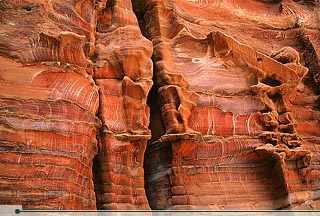 |
Keys
to the Kingdom National Anthem The Office History |
|
Before Alexander’s conquest, a thriving new civilization had emerged in southern Jordan. It appears that a nomadic tribe known as the Nabateans began migrating gradually from Arabia during the sixth century BCE. Over time, they abandoned their nomadic ways and settled in a number of places in southern Jordan, the Naqab desert in Palestine, and in northern Arabia. Their capital city was the legendary Petra, Jordan’s most famous tourist attraction. Although Petra was inhabited by the Edomites before the arrival of the Nabateans, the latter carved grandiose buildings, temples and tombs out of solid sandstone rock. They also constructed a wall to fortify the city, although Petra was almost naturally defended by the surrounding sandstone mountains. Building an empire in the arid desert also forced the Nabateans to excel in water conservation. They were highly skilled water engineers, and irrigated their land with an extensive system of dams, canals and reservoirs. |
 |
||
| Close-up of red sandstone, Petra. © Michelle Woodward | ||
| The
Nabateans were exceptionally skilled traders, facilitating commerce between China, India,
the Far East, Egypt, Syria, Greece and Rome. They dealt in such goods as spices, incense,
gold, animals, iron, copper, sugar, medicines, ivory, perfumes and fabrics, just to name a
few. From its origins as a fortress city, Petra became a wealthy commercial crossroads
between the Arabian, Assyrian, Egyptian, Greek and Roman cultures. Control of this crucial
trade route between the upland areas of Jordan, the Red Sea, Damascus and southern Arabia
was the lifeblood of the Nabatean Empire. We still know comparatively little about Nabatean society. However, we do know that they spoke a dialect of Arabic and later on adopted Aramaic. Much of what is now known about Nabatean culture comes from the writings of the Roman scholar Strabo. He recorded that their community was governed by a royal family, although a strong spirit of democracy prevailed. According to him there were no slaves in Nabatean society, and all members shared in work duties. The Nabateans worshipped a pantheon of deities, chief among which were the sun god Dushara and the goddess Allat. As the Nabateans grew in power and wealth, they attracted the attention of their neighbors to the north. The Seleucid King Antigonus, who had come to power when Alexander’s empire was divided, attacked Petra in 312 BCE. His army met with relatively little resistance, and was able to sack the city. The quantity of booty was so great, however, that it slowed their return journey north and the Nabateans were able to annihilate them in the desert. Records indicate that the Nabateans were eager to remain on good terms with the Seleucids in order to perpetuate their trading ambitions. Throughout much of the third century BCE, the Ptolemies and Seleucids warred over control of Jordan, with the Seleucids emerging victorious in 198 BCE. Nabatea remained essentially untouched and independent throughout this period. Although the Nabateans resisted military conquest, the Hellenistic culture of their neighbors influenced them greatly. Hellenistic influences can be seen in Nabatean art and architecture, especially at the time that their empire was expanding northward into Syria, around 150 BCE. However, the growing economic and political power of the Nabateans began to worry the Romans. In 65 BCE, the Romans arrived in Damascus and ordered the Nabateans to withdraw their forces. Two years later, Pompey dispatched a force to cripple Petra. The Nabatean King Aretas III either defeated the Roman legions or paid a tribute to keep peace with them. The assassination of Julius Caesar in 44 BCE augured a period of relative anarchy for the Romans in Jordan, and the Parthian kings of Persia and Mesopotamia took advantage of the chaotic situation to attack. The Nabateans made a mistake by siding with the Parthians in their war with the Romans, and after the Parthians’ defeat, Petra had to pay tribute to Rome. When they fell behind in paying this tribute, they were invaded twice by the Roman vassal King Herod the Great. The second attack, in 31 BCE, saw him take control of a large swath of Nabatean territory, including the lucrative northern trading routes into Syria. |
 Riding through the Siq, Petra. © Jad Al Younis, Discovery Eco-Tourism |
Nonetheless, the Nabateans continued to prosper for a while. King Aretas IV, who ruled from 9 BCE to 40 CE, built a chain of settlements along the caravan routes to develop the prosperous incense trade. The Nabateans realized the power of Rome, and subsequently allied themselves with the Romans to quell the Jewish uprising of 70 CE. However, it was only a matter of time before Nabatea would fall under direct Roman rule. The last Nabatean monarch, Rabbel II, struck a deal with the Romans that as long as they did not attack during his lifetime, they would be allowed to move in after he died. Upon his death in 106 CE, the Romans claimed the Nabatean Kingdom and renamed it Arabia Petrea. The city of Petra was redesigned according to traditional Roman architectural designs, and a period of relative prosperity ensued under the Pax Romana. |
| The Nabateans profited for a while from their incorporation into the trade routes of the Roman Near East, and Petra may have grown to house 20,000-30,000 people during its heyday. However, commerce became less profitable to the Nabateans with the shift of trade routes to Palmyra in Syria and the expansion of seaborne trade around the Arabian peninsula. Sometime probably during the fourth century CE, the Nabateans left their capital at Petra. No one really knows why. It seems that the withdrawal was an unhurried and organized process, as very few silver coins or valuable possessions have been unearthed at Petra. |